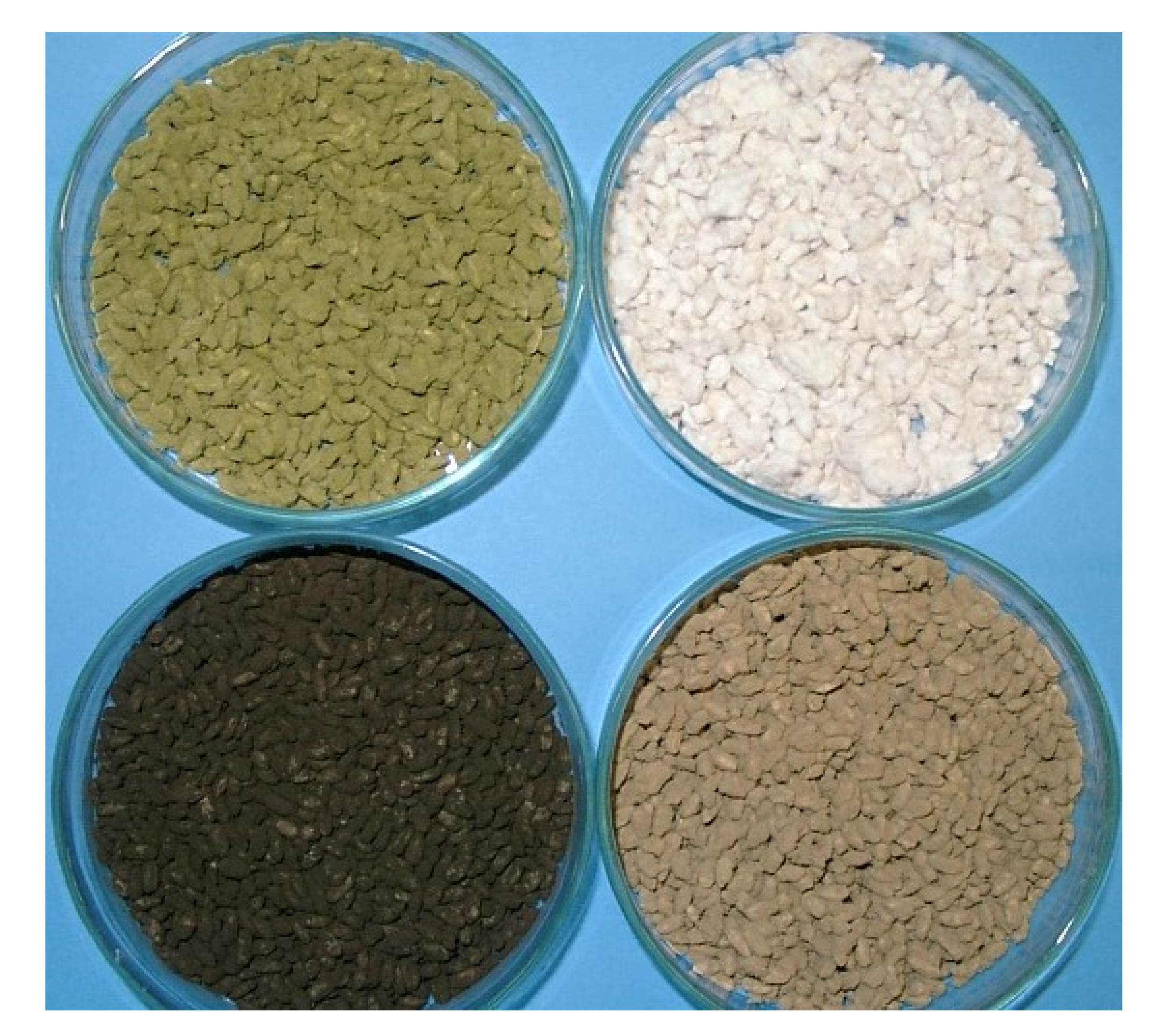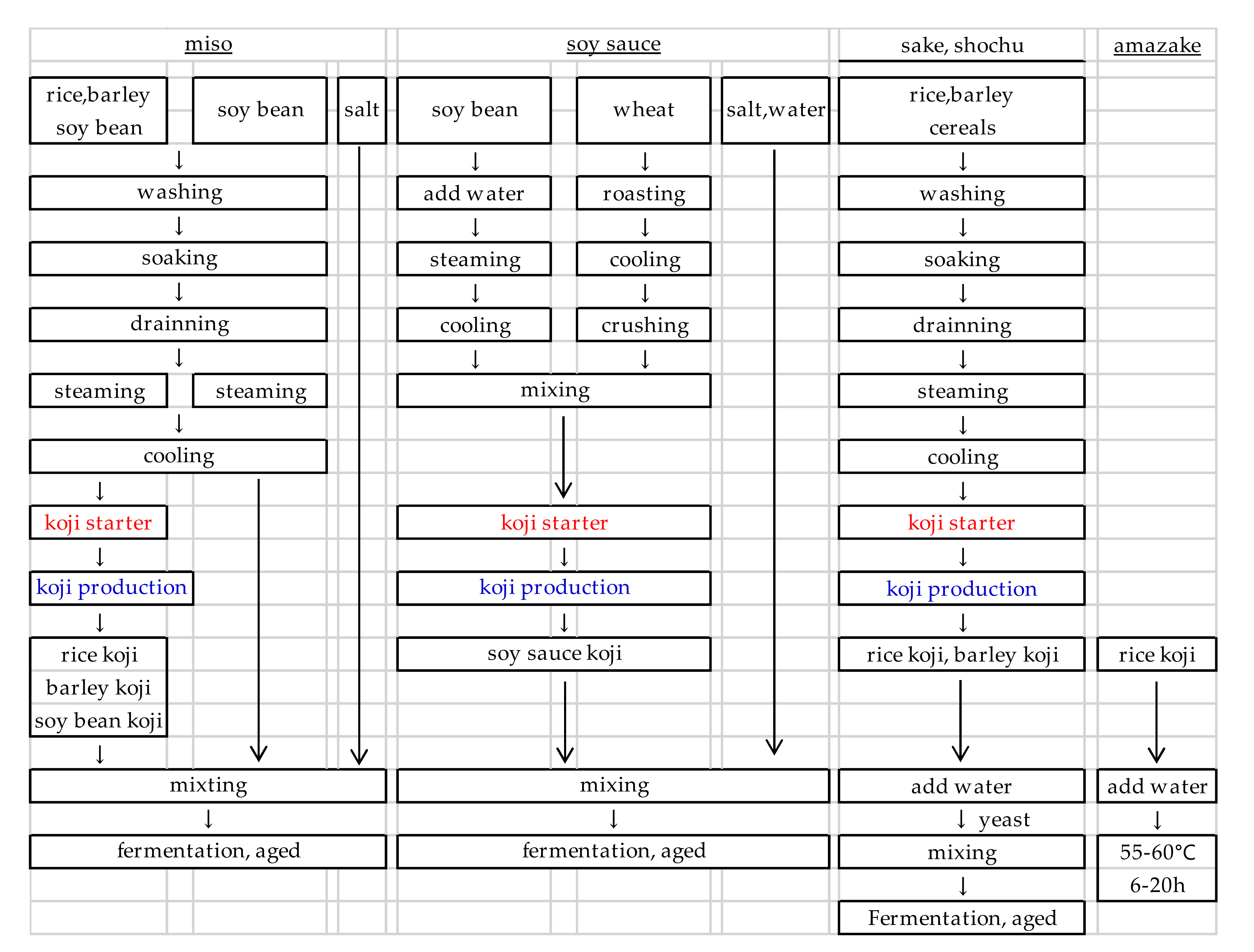Koji Starter and Koji World in Japan
Abstract
:1. Introduction
- (1)
- Aspergillus oryzae, “kikōji-kin” in Japanese.
- (2)
- Aspergillus sojae belonging to the A. oryzae group and their albino mutant strains.(Please note, A. sojae and A. oryzae are different species. This follows the taxonomy in the Japanese brewing industry and means that both belong to the group that forms yellow-green spores.)
- (3)
- Black Aspergilli group, namely Aspergillus luchuensis (A. luchuensis var. awamori), “kurokōji-kin” in Japanese, and its albino mutant A. luchuensis mut. kawachii (A. kawachii), “shirokōji-kin”.(Please note, A. niger is a different species from the black Aspergilli group, so it is excluded.)
2. Historical Background of Koji Starter and Koji
2.1. Generation of Koji and Koji Mold
2.2. Changes in the Classification of Koji Mold
2.3. Current Koji Starter Industry
3. Industrial Koji Starter
3.1. Method for Producing Koji Starter
3.1.1. Materials
3.1.2. Moisture Content
3.1.3. Preparation of Koji Materials
3.1.4. Inoculation
3.1.5. Culturing
3.1.6. Drying
3.1.7. Sieving
3.1.8. Preservation of Koji Strains
3.2. About Koji Starter
3.3. Fermented Food and Koji
3.3.1. Brewing Industry in Japan
3.3.2. How Koji Works
4. Koji Starter and Koji Suitable for the Production of Each Fermented Food
4.1. Sake
4.2. Shochu
4.3. Soy Sauce
4.4. Miso
4.5. Others
4.6. Diversity of Koji Mold
4.7. The Method of Koji Production
4.7.1. Koji Production Process Differs Depending on Fermented Food
4.7.2. Prevention of Bacteria Contamination
5. Recent Topics on the Use of Koji Mold and Koji
5.1. Ocha (Tea) Koji
5.2. Seaweed Koji
5.3. Egg Koji
5.4. Koji Cheese
5.5. Liquid Culture of Koji Mold
6. Conclusions
Funding
Institutional Review Board Statement
Informed Consent Statement
Data Availability Statement
Conflicts of Interest
References
- Ichishima, E. Declaration We, the Scientific Conference of Brewing Society Japan Authorize “Koji Fungi (Kōji-kin)” as the National Fungi. Available online: https://www.jozo.or.jp/gakkai/wp-content/uploads/sites/4/2020/02/koujikinnituite2.pdf (accessed on 24 May 2021).
- United Nations Educational, Scientific and Cultural Organization. Washoku, Traditional Dietary Cultures of the Japanese, Notably for the Celebration of New Year. Available online: https://ich.unesco.org/en/RL/washoku-traditional-dietary-cultures-of-the-japanese-notably-for-the-celebration-of-new-year-00869 (accessed on 24 May 2021).
- Hong, S.B.; Lee, M.; Kim, D.H.; Varga, J.; Frisvad, J.C.; Perrone, G.; Gomi, K.; Yamada, O.; Machida, M.; Houbraken, J.; et al. Aspergillus luchuensis, an Industrially Important Black Aspergillus in East Asia. PLoS ONE 2013, 8, e63769. [Google Scholar] [CrossRef] [Green Version]
- Abe, M.; Kobari, S.; Akita, O. The Characteristic Variations between the Commercial Aspergillus oryzae Strains and Wild Strains Isolated from the Field. Proc. Jissen Women’s Univ. Fac. Human Life Sci. 2012, 49, 7–14. (In Japanese) [Google Scholar]
- Okazaki, N. Traditional alcoholic beverage and its Koji in Japan, China and Southeast Asia. J. Brew. Soc. Japan 2009, 104, 951–957. (In Japanese) [Google Scholar] [CrossRef]
- Tanaka, T.; Okazaki, N. Growth of mold uncoocked grain. Hakkokogaku 1982, 60, 11–17. (In Japanese) [Google Scholar]
- Hoffmann, T.E. Ueber die Bereitung von Shoju, Sake und Myrin. Mitt. Deutsch. Ges. Nat. Völkerkd Ostasiens 1876, 6, 8–11. [Google Scholar]
- Nojiro, K. Introduction of Japanese Brewing Methods in Europe and the United States in the early Meiji period. Jpn. J. History Brew. 1984, 1, 101–120. (In Japanese) [Google Scholar]
- Atkinson, R.W. Brewing in Japan. Nature 1878, 18, 521–523. [Google Scholar] [CrossRef]
- Murakami, H. Hermann Ahlburg and some Persons Concerned-The First Identification of the Koji-mold in 1878. J. Brew. Soc. Japan 1994, 89, 889–894. (In Japanese) [Google Scholar] [CrossRef] [Green Version]
- Wannop, C.C. The Histopathology of Turkey “X” Disease in Great Britain. Avian Dis. 1961, 5, 371–381. [Google Scholar] [CrossRef]
- Benkerroum, N. Aflatoxins: Producing-Molds, Structure, Health Issues and Incidence in Southeast Asian and Sub-Saharan African Countries. Int. J. Environ. Res. Public Health 2020, 17, 1215. [Google Scholar] [CrossRef] [Green Version]
- Thom, C.; Raper, K.B. A Manual of the Aspergilli. Nature 1946, 157, 462. [Google Scholar] [CrossRef]
- Murakami, H. Classification of the koji mold. J. Appl. Microbiol. 1971, 17, 281–309. (In Japanese) [Google Scholar] [CrossRef] [Green Version]
- Kurtzman, C.P.; Smiley, M.J.; Robnett, C.J.; Wicklow, D.T. DNA relatedness among wild and domesticated species in the Aspergillus flavus group. Mycologia 1986, 78, 955–959. [Google Scholar] [CrossRef]
- Gomi, K. Molecular Biological Approach to the Taxonomy of Koji Molds. J. Brew. Soc. Jpn. 1989, 84, 669–674. (In Japanese) [Google Scholar] [CrossRef]
- Machida, M.; Asai, K.; Sano, M.; Tanaka, T.; Kumagai, T.; Terai, G.; Kusumoto, K.; Arima, T.; Akita, O.; Kashiwagi, Y.; et al. Genome sequencing and analysis of Aspergillus oryzae. Nature 2005, 438, 1157–1161. [Google Scholar] [CrossRef] [PubMed] [Green Version]
- Tominaga, M.; Lee, Y.H.; Hayashi, R.; Suzuki, Y.; Yamada, O.; Sakamoto, K.; Gotoh, K.; Akita, O. Molecular Analysis of an Inactive Aflatoxin Biosynthesis Gene Cluster in Aspergillus oryzae RIB Strains. Appl. Environ. Microbiol. 2006, 72, 484–490. [Google Scholar] [CrossRef] [PubMed] [Green Version]
- Kiyota, T.; Hamada, R.; Sakamoto, S.; Iwashita, K.; Yamada, O.; Mikami, S. Aflatoxin non-productivity of Aspergillus oryzae caused by loss of function in the aflJ gene product. J. Biosi. Bioeng. 2011, 111, 512–517. [Google Scholar] [CrossRef] [PubMed]
- Gibbons, J.G.; Salichos, L.; Slot, J.C.; Rinker, D.C.; McGary, K.L.; King, J.G.; Klich, M.A.; Tabb, D.L.; McDonald, W.H.; Rokas, A. The Evolutionary Imprint of Domestication on Genome Variation and Function of the Filamentous Fungus Aspergillus oryzae. Curr. Biol. 2012, 22, 1403–1409. [Google Scholar] [CrossRef] [PubMed] [Green Version]
- Sato, A.; Oshima, K.; Noguchi, H.; Ogawa, M.; Takahashi, T.; Oguma, T.; Koyama, Y.; Itoh, T.; Hattori, M.; Hanya, Y. Draft genome sequencing and comparative analysis of Aspergillus sojae NBRC 4239. DNA Res. 2011, 18, 165–176. [Google Scholar] [CrossRef] [Green Version]
- Takahashi, T.; Chang, P.K.; Matsushima, K.; Yu, J.; Keietsu Abe, K.; Bhatnagar, D.; Cleveland, T.E.; Koyama, Y. Nonfunctionality of Aspergillus sojae aflR in a strain of Aspergillus parasiticus with a disrupted aflR Gene. Appl. Environ. Microbiol. 2002, 68, 3737–3743. [Google Scholar] [CrossRef] [Green Version]
- Yamada, O.; Machida, M.; Hosoyama, A.; Goto, M.; Takahashi, T.; Futagami, T.; Yamagata, Y.; Takeuchi, M.; Kobayashi, T.; Koike, H.; et al. Genome sequence of Aspergillus luchuensis NBRC4314. DNA Res. 2016, 23, 507–515. [Google Scholar] [CrossRef] [Green Version]
- Yamada, O.; Takara, R.; Hamada, R.; Hayashi, R.; Tsukahara, M.; Mikami, S. Molecular biological researches of Kuro-Koji molds, their classification and safety. J. Biosci. Bioeng. 2011, 112, 233–237. [Google Scholar] [CrossRef]
- Narahara, H.; Koyama, Y.; Yoshida, T.; Pichangkura, S.; Ueda, R.; Taguchi, H. Growth and Enzyme Production in a Solid-State Culture of Aspergillus oryzae. J. Ferment. Technol. 1982, 60, 311–319. [Google Scholar]
- Kaneko, A.; Ozeki, K. Selective production of cellulase and hemicellulase from Aspergillus oryzae using starch-free wheat bran (in Japanese). J. Brew. Soc. Jpn. 2017, 112, 77–81. [Google Scholar] [CrossRef]
- Hata, Y.; Ishida, H.; Kojima, Y.; Ichikawa, E.; Kawato, A.; Suginami, K.; Imayasu, S. Comparison of two glucoamylases produced by Aspergillus oryzae in solid-state culture (koji) and in submerged culture. J. Ferment. Bioeng. 1997, 84, 532–537. [Google Scholar] [CrossRef]
- Ishida, H.; Hata, Y.; Ichikawa, E.; Kawato, A.; Suginami, K.; Imayasu, S. Regulation of the glucoamylase-encoding gene (glaB), expressed in solid-state culture (koji) of Aspergillus oryzae. J. Ferment. Bioeng. 1998, 86, 301–307. [Google Scholar] [CrossRef]
- Kitano, H.; Kataoka, K.; Furukawa, K.; Hara, S. Specific expression and temperature-dependent expression of the acid protease-encoding gene (pepA) in Aspergillus oryzae in solid-state culture (Rice-Koji). J. Ferment. Bioeng. 2002, 93, 563–567. [Google Scholar] [CrossRef]
- Watanabe, Y.; Hayakawa, K.; Ueno, H. Improvement of the Taste of Tea Leaves by Treating with Malt. J. Home Econ. Jpn. 2008, 59, 999–1004. (In Japanese) [Google Scholar]
- Uchida, M.; Hideshima, N.; Araki, T.; Sugiura, Y.; Murase, N.; Murayama, F.; Iida, M. Preparation of seaweed cultures grown with the koji mold Aspergillus oryzae. J. Brew. Soc. Jpn. 2020, 115, 589–603. [Google Scholar]
- Kewpie Corp. Available online: https://www.kewpie.com/en/rd/material/jyukuseiranou_01/ (accessed on 4 June 2021).
- Suzuki, S.; Ohmori, H.; Hayashida, S.; Nomura, M.; Kobayashi, M.; Hagi, T.; Narita, T.; Tomita, S.; Yamashita, H.; Arakawa, Y.; et al. Lipase and protease activities in Koji cheeses surface-ripened with Aspergillus strains. Food Sci. Technol. Res. 2021, 27, 543–549. [Google Scholar] [CrossRef]
- Masuda, S.; Shoji, H. Development of a submerged culture method for high production of acid- stable α-amylase and glucoamylase using Aspergillus kawachii without glucose concentration control. J. Inst. Brew. 2012, 118, 346–351. [Google Scholar] [CrossRef] [Green Version]







| Glucoamylase | Alpha-Amylase | Protease (pH 3) | Protease (pH 6) | |
|---|---|---|---|---|
| Millet | 1.6 | 2.1 | 3.5 | 2.5 |
| Germ of rice | 1.9 | 4.5 | 2.6 | 4.4 |
| Barley | 1.4 | 1.7 | 1.7 | 1.5 |
| Adlay | 1.0 | 1.0 | 1.0 | 1.0 |
| Brown rice | 1.7 | 2.2 | 1.9 | 1.4 |
| Buckwheat | 1.4 | 1.4 | 2.1 | 1.6 |
| Soybean | 1.7 | 2.6 | 0.4 | 2.1 |
| Rice protein | 2.2 | 15.1 | 0.2 | 5.7 |
| Soy pulp | 2.6 | 13.7 | 5.8 | 11.7 |
| Quinoa | 1.3 | 1.5 | 1.0 | 0.9 |
Publisher’s Note: MDPI stays neutral with regard to jurisdictional claims in published maps and institutional affiliations. |
© 2021 by the author. Licensee MDPI, Basel, Switzerland. This article is an open access article distributed under the terms and conditions of the Creative Commons Attribution (CC BY) license (https://creativecommons.org/licenses/by/4.0/).
Share and Cite
Yamashita, H. Koji Starter and Koji World in Japan. J. Fungi 2021, 7, 569. https://doi.org/10.3390/jof7070569
Yamashita H. Koji Starter and Koji World in Japan. Journal of Fungi. 2021; 7(7):569. https://doi.org/10.3390/jof7070569
Chicago/Turabian StyleYamashita, Hideyuki. 2021. "Koji Starter and Koji World in Japan" Journal of Fungi 7, no. 7: 569. https://doi.org/10.3390/jof7070569
APA StyleYamashita, H. (2021). Koji Starter and Koji World in Japan. Journal of Fungi, 7(7), 569. https://doi.org/10.3390/jof7070569





